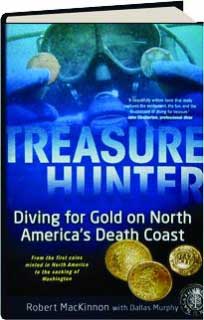Treasure HunterContents of this Issue: Let Someone Else Plan Your Dive Trip for You Damai I, Raja Ampat, Indonesia An Underwater Attack Makes World Headlines The Foolishness of Leaving Your Dive Boat Unmanned The Case for Downloading Your Dives Youíre Flippant and Disrespectful, Ben Davison Editorial Office: Ben Davison Publisher and Editor Undercurrent 3020 Bridgeway, Suite 102 Sausalito, CA 94965 from the June, 2014 issue of Undercurrent
When I think of diving for sunken treasure, my imagination usually takes me to the tropics. However, Robert MacKinnon made a career out of salvaging coins, silverware, weapons and other valuable artifacts from sailing ships that met their end in the dangerous shallows off Nova Scotia's Cape Breton Island. The "Death Coast" is known for its strong currents, rocky shoals and submerged rocks. In his book Treasure Hunter: Diving for Gold on North America's Death Coast," MacKinnon and co-author Dallas Murphy tell the story of 40 years of exploration. British colonists of the 17th century initially traded wampum (strings of mussel shells) with the natives, but soon demanded hard currency from home, so London launched fleets laden with coins for the New World. Some ships never made it.
The authors do a thorough job depicting the challenges of underwater salvage, and telling the stories of the ships and sailors who went down with their treasures. They're just as thorough when describing the hassles that MacKinnon and his partners run into with an alphabet soup's worth of federal and provincial agencies, and they add a laborious appendix covering technical, historical and legal issues, which I might just as well have skipped. Regardless, the book is still a good yarn. Although MacKinnon recovered millions of dollars' worth of treasure over four decades, the book does not have a happy ending. I'll spare you the details, but suffice it to say that the Nova Scotia government has essentially ended all commercial underwater treasure hunting along its coast. Buy this 331-page paperback through our website ( it's posted on our homepage at www.undercurrent.org ), and you'll get Amazon's best price, as well as help us with our efforts to protect coral reefs worldwide. --Larry Clinton |

I want to get all the stories! Tell me how I can become an Undercurrent Online Member and get online access to all the articles of Undercurrent as well as thousands of first hand reports on dive operations world-wide
| Home | Online Members Area | My Account |
Login
|
Join
|
| Travel Index |
Dive Resort & Liveaboard Reviews
|
Featured Reports
|
Recent
Issues
|
Back Issues
|
|
Dive Gear
Index
|
Health/Safety Index
|
Environment & Misc.
Index
|
Seasonal Planner
|
Blogs
|
Free Articles
|
Book Picks
|
News
|
|
Special Offers
|
RSS
|
FAQ
|
About Us
|
Contact Us
|
Links
|
3020 Bridgeway, Ste 102, Sausalito, Ca 94965
All rights reserved.

 Diving as a teenager in the '60s in 34-degree
water wearing just half a wetsuit, MacKinnon began
discovering a king's ransom scattered along the inhospitable
ocean floor. Once afflicted with "gold fever,"
MacKinnon started navigating not just these waters, but
also the equally icy Nova Scotia bureaucracy for salvage
rights. Along the way MacKinnon made some intriguing
discoveries, including silverware that may have been
looted from Dolly Madison's White House dinner table
during the War of 1812.
Diving as a teenager in the '60s in 34-degree
water wearing just half a wetsuit, MacKinnon began
discovering a king's ransom scattered along the inhospitable
ocean floor. Once afflicted with "gold fever,"
MacKinnon started navigating not just these waters, but
also the equally icy Nova Scotia bureaucracy for salvage
rights. Along the way MacKinnon made some intriguing
discoveries, including silverware that may have been
looted from Dolly Madison's White House dinner table
during the War of 1812.